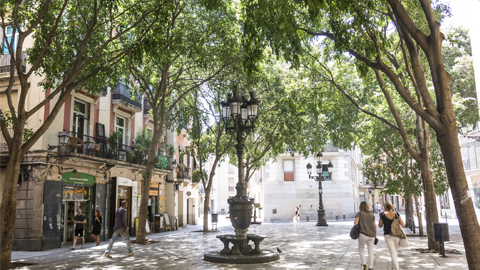Barcelona's lower income neighbourhoods have more trees in public spaces
Researchers from CREAF and the UAB analysed almost 230,000 trees located in all neighbourhoods of Barcelona and then linked them to socio-economic factors such as age, income per capita and life expectancy. The results were recently published in the journal Landscape & Urban Planning.

The study shows that Barcelona's lower income per capita neighbourhoods have more urban greenery, because they have more trees in public spaces and a similar number of species compared to those with higher incomes. This is due to the fact that the less affluent and more densely populated neighbourhoods have roundabouts and flowered squares, trees in the streets, shrubs and small landscaped areas that compensate for the lack of large green infrastructures that exist in the more affluent neighbourhoods.
In addition, the data shows that the Barcelona neighbourhoods with the longest life expectancy have more trees and more different species, demonstrating that better access to nature can be related to better human health. "More research will have to be done to determine whether this is a direct cause, as has been found in other cities," warns Josep Padullés, CREAF researcher and associate professor in the Department of Animal Biology, Plant Biology and Ecology. A growing body of research shows that access to green spaces has significant benefits for mental and physical health, social cohesion and quality of life in general. These benefits are often related to the fact that urban green spaces reduce stress levels, promote physical activity, improve local climates and reduce air pollution.
Therefore, the results obtained make it possible to establish a ranking of both the neighbourhoods that are the greenest and those that are the least in Barcelona. Sant Pere, Santa Caterina i la Ribera, La Guineueta and Poble Sec-Parc de Montjuïc are the neighbourhoods with the greatest diversity of trees. In contrast, Sants-Badal, Can Peguera and La Clota have the least variety. In terms of number of trees, Horta, Poble Sec-Parc de Montjuïc and Pedralbes occupy the highest positions in the ranking, while Vallvidrera, Tibidabo and Les Planes, Vallbona and La Clota have the lowest.
To carry out this study CREAF and the UAB analysed almost 230,000 trees in all the city's neighbourhoods and linked them to socio-economic factors such as age, income per capita and life expectancy. Furthermore, only public spaces in the city were taken into account, not private home gardens or peri-urban areas.
Diversity is on the streets
The study, which also included the participation of Javier Retana, CREAF researcher and lecturer in the Department of Animal Biology, Plant Biology and Ecology at the UAB, shows that this green is not evenly distributed: most of the city's trees are found on the streets (67%), followed closely by trees in the surrounding area (18%) - in squares, roundabouts, etc. - and parks (15%). In terms of diversity, on average, streets also have a greater richness of tree species than neighbourhood parks. The reason, as is well known, is that many parks tend to have areas of monoculture of grass or large plantations of the same tree species for aesthetic reasons.
Less cars, more trees
Barcelona has about 7 m² of green space per inhabitant, which is low compared to other cities, but is compensated by the high density of street trees (about 100 street trees per 1,000 inhabitants). The authors warn that the lack of space and the compact form of cities can limit the growth of urban greenery, so transforming the street network, for example by reducing the number of private traffic lanes, can open up new opportunities to increase tree planting and its benefits.
"This study is an example of the efforts needed to understand the complexity of urban ecosystems and their relationship with inhabitants. More research is needed to improve knowledge for sustainable urban planning and green space design that promotes a more equitable distribution. According to our results, planners and policy makers should not assume that increasing tree cover or green space will always lead to higher income levels on its own. Instead, they need to take a more targeted approach and address the barriers that prevent certain social groups from accessing trees and green spaces," concludes Padullés.
Article: Padullés Cubino, J.; Retana, J (2023). Socioeconomics explain tree diversity, abundance, and composition in the compact city of Barcelona, Spain. Landscape and Urban Planning, Vol. 236, 104778, ISSN 0169-2046. https://doi.org/10.1016/j.landurbplan.2023.104778